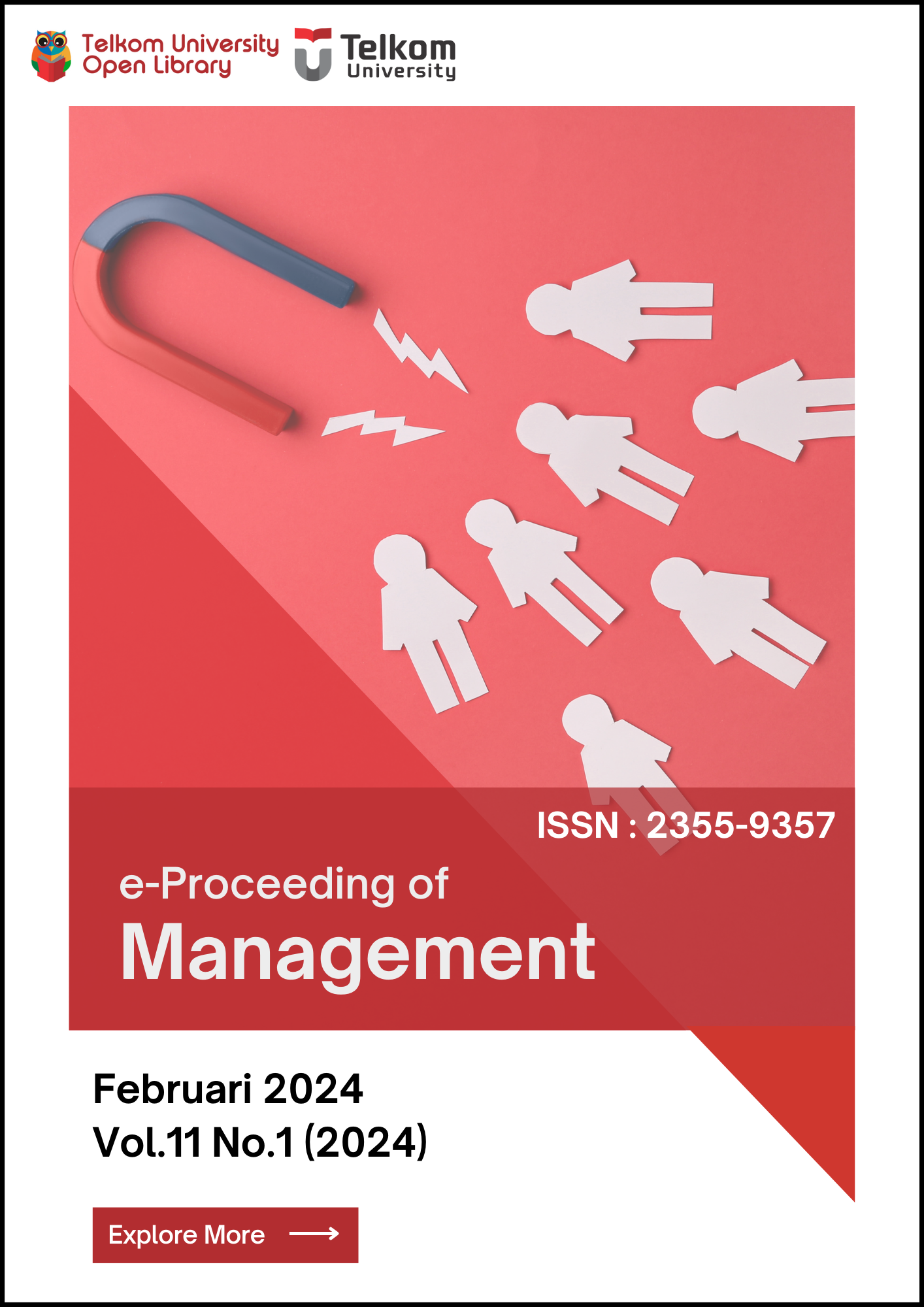Pengaruh Social Media Marketing Activity Instagram Terhadap Purchase Intention Dengan Brand Equity Dan Electronic Word Of Mouth Sebagai Variabel Intervening Di Pass The Trend Bandung
Abstract
Kemajuan teknologi internet dan adanya media sosial merupakan kesempatan yang tepat untuk membuka bisnis secara daring ditengah perkembangan internet dalam segala aspek masyarakat. Salah satu penerapan teknologi tersebut yaitu penggunaan strategi pemasaran yang dapat dilakukan melalui media sosial. Penelitian ini bertujuan untuk mengetahui apakah social media marketing activity yang dilakukan oleh Pass The Trend memiliki pengaruh positif terhadap brand equity, penyebaran e-WOM di media sosial, dan purchase intention pelanggan. Model pengukuran SEM-PLS dan pendekatan kuantitatif digunakan dalam metodologi penelitian ini. Pengambilan data responden dilakukan melalui penyebaran kuesioner terhadap 400 partisipan pengguna media sosial Instagram yang pernah mengakses akun Instagram Pass The Trend. Penelitian menunjukkan bahwa social media marketing activity berdampak positif terhadap purchase intention. Selain itu, brand equity juga dinilai berpengaruh positif terhadap e-WOM dan e-WOM tetap mempengaruhi purchase intention secara positif. Hasil penelitian ini dimaksudkan sebagai evaluasi bagi Pass The Trend, memberikan wawasan mengenai cara meningkatkan dan menerapkan social media marketing activity di Instagram secara efektif. Hal ini diharapkan dapat meningkatkan brand equity dan e-WOM Pass The Trend.
Kata Kunci-teknologi, social media marketing activity, brand equity, e-WOM, purchase intention.
References
Aaker, D. A. (1991). Managing Brand Equity: Capitalizing on the Value of a Brand Name. New York: The Free Press.
Aji, P. M., Nadhila, V., & Sanny, L. (2020) Effect of social media marketing on Instagram towards purchase intention:
Evidence from Indonesia's ready-to-drink tea industry. International Journal of Data and Network Science,
(2), 91-104. https://doi.org/ 10.5267/j.ijdns.2020.3.002
Alalwan, A. A., Rana, N. P., Dwivedi, Y.K., & Algharabat, R. (2017). Social media in marketing: A review and
analysis of the existing literature. Telematics and Informatics, 34(7), 1177-1190.
Anggadwita, G., Rikumahu, B., Hendayani, R. & Putra, R., R. (2020). Measuring the effectiveness of social media
owned by local government leaders in communicating smart city programs. 2020 8th International Conference
on Information and Communication Technology (ICoICT), Yogyakarta, Indonesia, pp. 1-5, doi:
1109/ICoICT49345.2020.9166182.
Anshori, Muslich dan Sri Iswati. (2009). Metodologi Penelitian Kuantitatif. Surabaya: Pusat Penerbitan dan
Percetakan UNAIR (AUP).
Bae, J. C. (2022). Internet Shopping Service Quality, Customer Satisfaction Research on the Impact of Repurchase
intention. Master's dissertation. Yonsei University.
Bilgin, Y. (2018). The effect of social media marketing activities on brand awareness, brand image and brand loyalty.
Business & Management Studies: An International Journal, 6(1), 128-148.
Brown, J. J., & Reingen, P. H. (1987). Social ties and word-of-mouth referral behaviour. Journal of Consumer
Research, 14(3), 350-362.
Firdiansyah, A. (2022, February 18). Memahami Social Media Marketing, dari Pengertian Sampai Strateginya.
Ghozali, I., & Latan, H. (2020). Partial Least Squares: Konsep, Teknik dan Aplikasi Menggunakan Program
SmartPLS 3.0 Untuk Penelitian Empiris (2nd ed., Vol. 2). Badan Penerbit Universitas Diponogoro.
Ghozali. (2020). Reliabilitas. In A. Marzuki, C. Armereo, & P. F. Rahayu, Praktikum Statistik (p. 66). Malang: Ahli
media Press.
Goyette I., Ricard, L., J., B., & F., M. (2010). e-WOM Scale: word-of-mouth measurement scale for e-services context.
Canadian Journal of Administrative Sciences/Revue Canadienne Des Sciences de l'Administration, 27(1), 5-
Herr, P. M., Kardes, F. R., & Kim, J. (1991). Effects of word-of-mouth and product attribute information on
persuasion: An accessibility-diagnosticity perspective. Journal of Consumer Research, 17(4), 454-462.
Hootsuite (We are Social): Indonesian Digital Report 2022. (2022). https://andi.link/hootsuite-we-are-socialindonesian-digital-report-2022/
Husnain, M., & Toor, A. (2017). The impact of social network marketing on consumer purchase intention in Pakistan:
Consumer engagement as a mediator. AJBA, 10(1), 167-199.
Hutter, K., Hautz, J., Dennhardt, S., & Fuller, J. (2013). The impact of user interactions in social media on brand
awareness and purchase intention: the case of MINI on Facebook. Journal of Product & Brand Management,
(5-6), 342-351.
Indrawati. (2015). Metode Penelitian Manajemen dan Bisnis Kovergensi Teknologi Komunikasi dan Informasi. Refika
Aditama.
Kim, A. J., & Ko, E. (2012). Do social media marketing activities enhance customer equity? An empirical study of
luxury fashion brand. Journal of Business Research, 65(10), 1480-1486.
Kim, A. J., & Ko, E. (2010). Impacts of luxury fashion brand's social media marketing on customer relationship and
purchase intention. Journal of Global Fashion Marketing, 1(3), 164-171.
https://doi.org/10.1080/20932685.2010.10593068.
Kotler, P., & Amstrong, G. (2016). Manajemen Pemasaran edisi 12 Jilid 1 & 2. Jakarta: PT. Indeks
Kotler, P., & Armstrong, G. (2019). Prinsip-prinsip Pemasaran Edisi 12 (12th ed., Vol 1). Erlangga.
Laksamana, P. (2018). International Review of Management and Marketing Impact of Social media Marketing on
Purchase intention and Brand Loyalty: Evidence from Indonesia's Banking Industry. International Review of
Management and Marketing, 8(1), 13-18. http;www.econjournals.com.
Nurdin, I., & Hartati, S. (2019). Metodologi Penelitian Sosial. Media Sahabat Cendekia.
Prasetio, A., Ahmad, R. H., Sari, P. K. & Sary, S. (2022). Social Capital and Electronic Word-Of-Mouth (eWOM)
Effect Toward Online Purchase intention. Journal of Computational and Theoretical Nanoscience, 23(11),
-10825.
Prasetio, A., Rahman, D. A., Sary, F. P., Pasaribu, R. D., & Sutjipto, M. R. (2022). The role of Instagram social media
marketing activities and brand equity towards airlines customer response. International Journal of Data and
Network Science, 6(4), 1195-1200.
Sekaran, U., & Bougie, R. (2016). Research methods for business: A skill building approach. John Wiley & Sons.
Seo, E., & Park, J. (2018). A Study On The Effects Of Social Media Marketing Activites On Brand equity And Customer
Response In The Airline Industry. Journal of Air Transport Management, 36-41.
Song, J.W. (2012). The Effects of the Advertising Value of SNS (Social Networking Service) on the Brand Equity,
Brand Loyalty of Food Service Industry. Master's dissertation. Sejong University.
Sugiyono. (2017). Metode Penelitian Kuantitatif, Kualitatif, dan R&D. Bandung: Alfabeta, CV.
Sugiyono. (2019). Statistika untuk Penelitian. CV Alfabeta.
Yadav, M., & Rahman, Z. (2017). Measuring consumer perception of social media marketing activities in e-commerce
industry: Scale development & validation. Telematics and Informatics, 34(7), 1294- 1307.
Zhu, F., & Zhang, X. (2010). Impact of online consumer reviews on sales: The moderating role of product and
consumer characteristics. Journal of Marketing, 74(2), 133-148.






